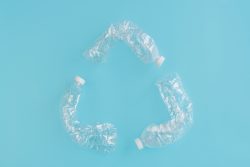From bin to new product, here’s how plastic bottles are recycled…
With 8 million tons of plastic escaping into our oceans every year, nearly 700 species of animal affected by this material, and microplastics being found in every corner of the globe, as a world, we have a huge problem – and it begins with ‘p’. But what is the solution? According to experts, it’s prevention; we need to prevent plastics from entering our waterways in the first place. We can do this by reducing how much we use, reusing what we’ve already got and – the one we want to concentrate on today – recycling.
Recycling treats “waste” as a resource, not to be thrown away, but to be turned into something new. This means, rather than ending up in our oceans, some plastics (not all are currently considered recyclable unfortunately) can be recycled into new products and used again. This maximises their potential as a resource, helps to contribute to a circular economy and, crucially, prevents them from adding to the plastics problem. It’s a no brainer, right? We certainly think so, and this is why, at Printwaste, we’re so passionate about recycling and helping our customers to do so too.
Now you know the why, we want to show you how this process actually happens. To do so, we’re going to take an item that’s widely consumed in the workplace as an example – the plastic bottle. From bin to new product, here’s how we recycle it…
Step 1
We’ll come and collect your plastic bottles (along with tins and cans) and transport them back to our recycling facility.
Step 2
Once there, we’ll use a magnet to separate the steel tins and an eddy current to separate the aluminium cans from the plastic bottles. The bottles will then be sent on to a specialist plastics reprocessing plant.
Step 3
At the plant, your plastic bottles will be shredded into flakes, then washed to remove any impurities, like leftover food and drink or remnants of paper labels.
Step 4
After this, the flakes will be dried and melted at temperatures of around 260°C, before being reformed into either pellets or fine spaghetti-like strands (dependent on what the plastic will be turned into).
Step 5
The pellets and spaghetti-like strands will then be sent on to plastics manufacturers, who will turn them back into plastic bottles or into other plastic products, such as clothing – ready to be sold all over again!
By sending your plastic bottles for recycling, you’ll:
- Help utilise a material to its fullest potential
- Conserve the world’s natural resources
- Save energy
- Reduce greenhouse gases and pollution
- Protect the oceans and the wildlife within them
- Keep plastic out of landfill
- Improve your environmental credentials
- Contribute towards your sustainability goals
Did you know? In the UK, we use 13 billion plastic bottles every year, and only 7.5 billion of these are recycled. Help us change that.
To find out more about plastic recycling, head to our dedicated plastics page on our website, give us a call on 01242 588600 or email us at info@printwaste.co.uk.


